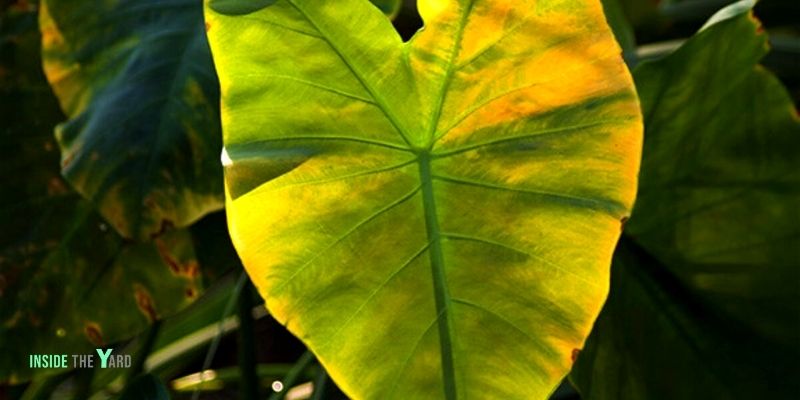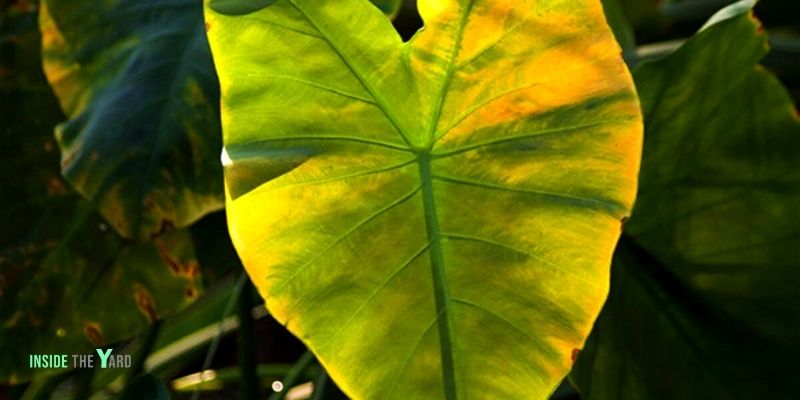
Are you asking the same question: why is my elephant ear turning yellow? One familiar reason behind the elephant ear being yellow is the imbalance of watering. If the rate of water with which you provide your elephant ear is not adjustable with your plants, generally, it turns yellow.
Some other valid reasons. Let’s take a look at them & their solutions.
Why is My Elephant Ear Turning Yellow?
| Reasons | Solutions |
| Less watering | Provide enough water |
| Lack of sunlight | Plant it in a place with ample sunlight |
| Pest attack | Use soap spray, different pesticides, and the neem oil |
| Less humidity | Serve adequate humidity phases through misting, pebble tray & humidifiers. |
| Dormancy | Cut off the yellow leaves and keep waiting for the new green leaves to grow |
Here is a compact depiction of the most common reasons along with their symptoms and their short solutions:
Lack of Watering
There lies a huge impact of watering your elephant plants on their growth and development. Usually, the elephant plants require a maximum amount of water, and if you don’t water them regularly, consequently, they will start turning yellow.
Solution: Pay close attention to the watering sector of your plants. Water them for about two to three inches of water every week.
As they are the affluent water drinkers because of the mighty water consumption, it grows pretty well.
Scarcity of Sunlight
The size of an elephant plant is comparatively larger than that of other plants. So, if indirect sunlight comes to the area of your plantation, gradually, the leaves will grow yellow.
In addition, too much sunlight also causes great harm to your plants.
Solution: Take a deep inspection of your elephant ear plants and carefully find out the yellowish conditions as early as possible. If you find out about this issue earlier, you can fight against it by only watering them properly.
Also, refrain from watering them more than the requirement as it will also create hazardous situations for you.
Try to maintain a healthy routine of watering so that you can be tension-free in this regard.
Little Pot
If the pot in which you have planted your elephant ear plant is a little bit smaller, then the leaves of your plant will begin to turn yellow.
The main reason behind this issue is the size requirement of the elephant ear plant. In fact, it is a possible issue why my potted elephant ears are turning yellow. It basically needs a bigger sized pot to fit.
Solution: Use comparatively larger sized pots to avoid the leaves becoming yellow due to tiny pots
Dormancy
You may notice the sudden change of the vibrant green color of your plant’s leaves. The exact reason lies in the fact of dormancy. If your plants are dormant for the season, you will notice that the greenish color will turn drastically to yellow.
Solution: There is nothing to do, especially for dormancy, as it is a part of natural consequences. Give the plants to take time in coping with the natural conditions.
Low Level of Humidity
Basically, the elephant ear plants cannot tolerate low humid weather conditions, and the irregular watering hinders the normal growth of your elephant ear plant. Moreover, they are not drought resistant.
So, for the cause of any imbalance related to the surrounding ecological conditions, the plants may arise yellow.
Solution: In that case, make sure to maintain proper care of your elephant ear plants.
Insect Infestation
One major cause behind the plants turning yellow is the infestation of pests in your plants.
Generally, some pests are predominantly efficient in sucking the sap of your elephant ear plant. Spider mites, mealybugs, and aphids make the plants weaker. In consequence, the leaves become yellow and fall down soon.
Solution: Spray your plants with soapy water weekly. Use several pesticides available in the market to destroy the insects, including their eggs fully.
These are actually the measures you can take against the fact of why my elephant ears are turning yellow and dying.
A Helpful Tutorial You May Need!
Frequently Asked Questions (FAQs)
Should I cut off yellow elephant ears?
Cutting off yellow elephant ears is a bit of a comfortable task. But the main issue regarding this is the perfect timing and also a very well pruning manner. Straightly cut the leaves located near the basement and rest the next 2 inches below.
What do you do with yellow elephant ears?
Except for the issue of dormancy, cutting the yellow leaves is the most effective solution you can apply as it will take time and in the next winter it will grow up again, and you won’t see any yellow one then. But in the case of dormancy, you basically are not required to do anything in this respect. Just let it be, it will be recovered over time.
How do you save yellowing elephant ears?
Water adequately and ensure sunlight to ensure proper nutrient supply to the elephant ear plant. To avoid the aspects of becoming yellow, use properly drained soil to grow your plant, and you can put them in a pot or handy container.
Final Thoughts
Elephant ear plants are one of the most disease-prone plants as your little carelessness in this regard can result in their damage and falling down.
Water them carefully by maintaining a regular schedule, daily inspecting their growth precisely. Take the necessary actions required to find out why is my elephant ear turning yellow.
You Can Also Read:
- Reasons Why Monstera Drooping After Repotting Can Be Shocking!
- Is Thyme An Annual Or Perennial Herb- A Brief Explanation
- Why Are My Watermelon Plants Dying? Reasons with Remedies
- Why Are the Stems on My Rose Bush Turning Black? Reasons with Resolves
- Why Is My Cosmos Not Flowering- Know the Reason to Help It Bloom
Was it helpful?

Often called Jason’s “better half” Shelley excels with her hands in the dirt. Growing up on a homestead in North Carolina gave Shelley a love for work and cultivation. Early in her career she cultivated minds inside a first grade classroom. Organic gardening has long been her passion and the internet age has allowed her to make it a side hustle. Shelley’s joy is made complete by sharing gardening tips with her friends, neighbors, and two grandsons.

